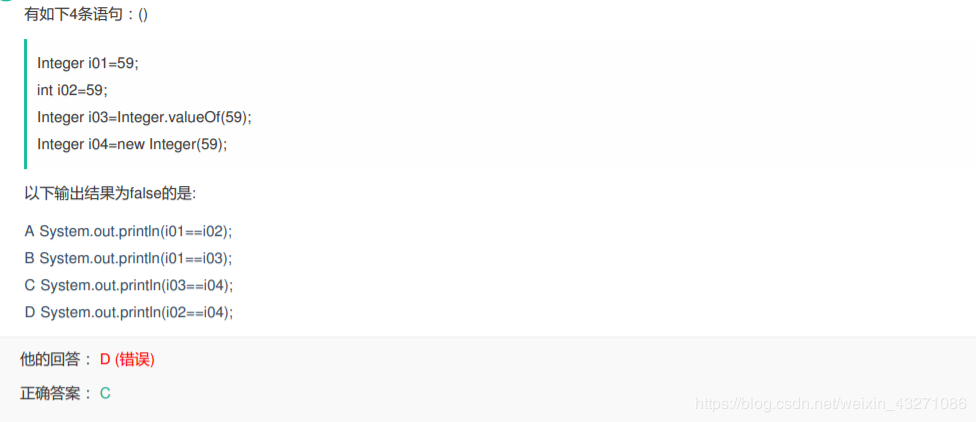本文是对 Integer.ValueOf()的一些了解,分享给大家

这道题有的人或许做过,也可能选对,但是这其中的道理你却不一定理解,在这里大牛走过,小白留下一起学习。

先来分析选型A,Integer i01 = 59,是一个装箱的过程,在进行i01 == i02的比较过程中,因为右边是整型,发生了拆箱的动作,所以进行了值得比较,所以返回true。
在这里拿出Integer a = 59,Integer b = 59,这种又会出现什么状况呢,如果按照装箱和拆箱来看就是true,如果按照对象来看,就是false,在你举棋不定得时候你就应该看看源码了。
/**
* Cache to support the object identity semantics of autoboxing for values between
* -128 and 127 (inclusive) as required by JLS.
*
* The cache is initialized on first usage. The size of the cache
* may be controlled by the {@code -XX:AutoBoxCacheMax=<size>} option.
* During VM initialization, java.lang.Integer.IntegerCache.high property
* may be set and saved in the private system properties in the
* sun.misc.VM class.
*/
private static class IntegerCache {
static final int low = -128;
static final int high;
static final Integer cache[];
static {
// high value may be configured by property
int h = 127;
String integerCacheHighPropValue =
sun.misc.VM.getSavedProperty("java.lang.Integer.IntegerCache.high");
if (integerCacheHighPropValue != null) {
try {
int i = parseInt(integerCacheHighPropValue);
i = Math.max(i, 127);
// Maximum array size is Integer.MAX_VALUE
h = Math.min(i, Integer.MAX_VALUE - (-low) -1);
} catch( NumberFormatException nfe) {
// If the property cannot be parsed into an int, ignore it.
}
}
high = h;
cache = new Integer[(high - low) + 1];
int j = low;
for(int k = 0; k < cache.length; k++)
cache[k] = new Integer(j++);
// range [-128, 127] must be interned (JLS7 5.1.7)
assert IntegerCache.high >= 127;
}
private IntegerCache() {}
}
这个类是Integer类中的一个静态内部类,其中的静态代码块在类进行加载的时候就进行了-127-128这些数字的创建和保存,将他们的引用全部保存在Cache数组中。
所以当用Integer 声明初始化变量时,会先判断所赋值的大小是否在-128到127之间,若在,则利用静态缓存中的空间并且返回对应cache数组中对应引用,存放到运行栈中,而不再重新开辟内存。
这里你就懂了吧,Integer a = 59,Integer b = 59返回的就是true,Integer a = 300,Integer b = 300在判断完之后就会new出来一个新的对象,所以会返回false。

我们来分析B选项,我们先来看Value的代码。
* @param i an {@code int} value.
* @return an {@code Integer} instance representing {@code i}.
* @since 1.5
*/
public static Integer valueOf(int i) {
if (i >= IntegerCache.low && i <= IntegerCache.high)
return IntegerCache.cache[i + (-IntegerCache.low)];
return new Integer(i);
和上面的一样,int进去之后首先进行判断,如果在-128-127之间就会返回引用,否则就在堆上new出来对象。所以B选项返回true。

C选项i03返回的是Cache数组中的引用,而i04返回的是堆上对象的引用,所以返回的是false。

System.out.println(i02== i04) i02是整型变量,i04是引用,这里又用到了解包,虚拟机会把i04指向的数据拆箱为整型变量再与之比较,所以比较的是数值,59==59,返回true.